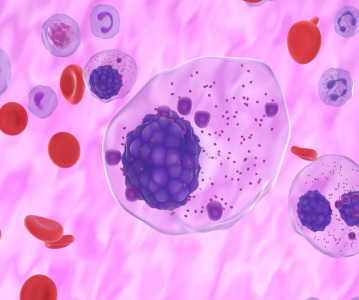New analysis of INPULSIS trials demonstrates efficacy of Ofev across a range of IPF patients using broader diagnostic criteria

Ofev is effective in slowing disease progression in both diagnostic subgroups which confirms the efficacy of OFEV across a range of IPF patients.
New analysis of the INPULSIS trials show for the first time that disease progression is similar in idiopathic pulmonary fibrosis (IPF) patients identified using a broader diagnostic definition compared with the current diagnostic guidelines. The post-hoc analysis of these 1,061 patients has now been published in the American Journal of Respiratory and Critical Care Medicine.
IPF is a devastating and fatal condition. Physicians use an imaging technique called high resolution computed tomography (HRCT) to help them identify the presence of scarring (fibrosis) and specifically the presence of usual interstitial pneumonia (UIP) pattern in the lungs to ensure an accurate diagnosis of IPF. Radiological changes called 'honeycombing' are a key indicator for lung fibrosis and a feature of the UIP pattern visible on HRCT. However, it can be challenging to confirm that scarring in the absence of honeycombing on HRCT that meets the strict guideline criteria for a definitive diagnosis of IPF. For a large group of patients who do not receive a confirmed diagnosis of IPF according to guidelines, including those not eligible for surgical lung biopsy, the clinical course of their condition and the effectiveness of IPF treatment remains unknown. Investigations into the behavior of the disease across diagnostic subgroups is therefore crucial.
The INPULSIS trials included patients with a classic diagnosis of IPF but also those patients with a clinical diagnosis of IPF who, in the absence of a surgical lung biopsy and honeycombing on HRCT, had a possible UIP pattern and the presence of traction bronchiectasis. Traction bronchiectasis is recognized as one of the most relevant CT signs of lung fibrosis. The analysis also shows that Ofev is effective in slowing disease progression in both diagnostic subgroups which confirms the efficacy of Ofev across a broad range of IPF patient types studied in Phase III and may be applicable to patients seen in clinical practice.
"In clinical practice, achieving a confident diagnosis of IPF is complex. While the accuracy of IPF diagnosis is increased by discussions among experts from multi-disciplinary services at regional centers with expertise in interstitial lung diseases, community physicians may more often make a diagnosis of IPF that does not always meet the criteria laid down by international guidelines," said Ganesh Raghu, Professor of Medicine, University of Washington in the Division of Pulmonary and Critical Care Medicine and Director of Center for Interstitial Lung Diseases at University of Washington Medical Center, Seattle, Washington. "This analysis confirms for the first time that disease progression and effect of treatment in a subgroup of patients not fully meeting the diagnostic criteria is similar to those meeting the current criteria, as defined in the 2011 international guidelines for diagnosis of IPF. This has implications to consider accepting the modified criteria, as used in this study for making a diagnosis of IPF that includes presence of possible UIP pattern and traction bronchiectasis in lower lobes (despite the absence of definite honeycombing on HRCT and surgical lung biopsy), in an appropriate clinical setting and in future clinical trials."
Related News
-
News BioNTech to begin mRNA vaccine manufacturing in Rwanda by 2025
German biotechnology company BioNTech has stated their intentions to begin production at their mRNA vaccine factory in Rwanda by 2025, which will mark the first foreign mRNA vaccine manufacturing site on the continent of Africa. -
News Identifying Alzheimer’s Disease biomarker proteins with whole blood tests
A University of Manchester spin-out pharmaceutical company, PharmaKure, has reported successful study results for the quantification of Alzheimer’s Disease biomarker proteins with a whole blood test. -
News Bill & Melinda Gates Foundation to boost mRNA vaccine initiatives in Africa with USD $40m
To address vaccine inequality and accessibility issues, the Bill & Melinda Gates Foundation aims to deliver USD $40m to various biotech companies and vaccine manufacturers in support of mRNA vaccine development. -
News CPHI Podcast Series: Exploring neurological frontiers in Alzheimer's and beyond
The next episode of the CPHI Podcast Series delves into the science and background behind some recent developments in the field of Alzheimer's disease and neurological disorders. -
News Is patient centricity the future of pharmaceutical manufacturing?
In this interview with Sandra Sánchez y Oldenhage, President of PharmAdvice, she speaks to the importance of considering patients in the manufacturing stages of the pharmaceutical supply chain, and how it can redefine healthcare. -
News CPHI Podcast Series: How to leverage AI for Drug Discovery
Artificial intelligence is the topic of debate in the latest episode from the CPHI Podcast Series, where Digital Editor Lucy Chard speaks with Bill Whitford of DPS Group about the integration of AI in healthcare. -
News Pfizer forges ahead with blood cancer therapy after approval from FDA
Pfizer gains accelerated approval from the US FDA for their new bispecific antibody therapy for multiple myeloma, set to address an unmet need for patients. -
News Alzheimer's drug donanemab deemed effective in landmark clinical trial
Results from the TRAILBLAZER-ALZ 2 Randomised Clinical Trial into the use of donanemab to treat early symptoms of Alzheimer’s disease have been analysed.
Position your company at the heart of the global Pharma industry with a CPHI Online membership
-
Your products and solutions visible to thousands of visitors within the largest Pharma marketplace
-
Generate high-quality, engaged leads for your business, all year round
-
Promote your business as the industry’s thought-leader by hosting your reports, brochures and videos within your profile
-
Your company’s profile boosted at all participating CPHI events
-
An easy-to-use platform with a detailed dashboard showing your leads and performance







